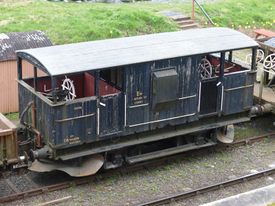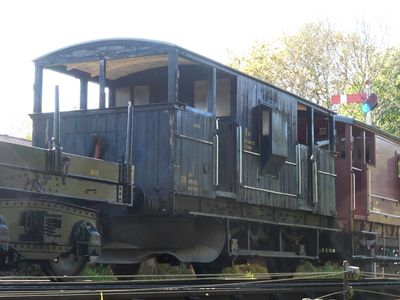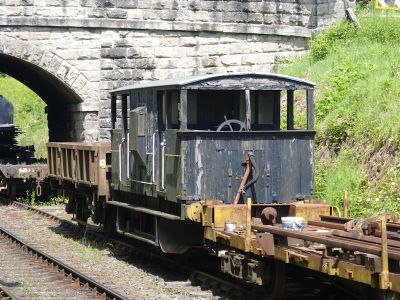BR 993898 'Shark' Ballast Plough Brake
| BR 993898 'Shark' Ballast Plough Brake | |
|---|---|
 BR Ballast Plough Brake DB 993898 | |
| Built By | BRCW Smethwick |
| Status | Overhaul |
| Number | DB 993898 |
| History | |
| Built | 1957 |
| Diagram | 1/597 |
| Lot | 3040 |
| Type | Ballast plough brake |
| Capacity | 20 tons |
| Telegraphic code | Shark |
| TOPS code | ZUV |
| Brakes | Vacuum braked |
| 1990 | Entered preservation on SVR |
| 1995-96 | Major restoration |
| 2004 | Overhaul |
As a ballast train moved slowly along a section of track, a plough attached to the last wagon would be used to spread the newly-dropped stone ballast. Since it was logical for the last vehicle to be a brake van, the LMS developed the idea of using a short wheelbase 16-ton brake van with a plough at each end mounted outside the wheelbase. Each plough could be raised or lowered as required according to the direction of travel. The LNER developed a similar idea using a 12-ton van with the ploughs between the wheels. BR experimented with both types, building 6 of the LNER type and 9 of the LMS type to Diagrams 1/595 and 1/596 respectively. A version of the LMS design using a heavier 20-ton van became the standard from 1951 onwards. A total of 206 of these were built to Diagram 1/597, all fitted with oil bearings and automatic vacuum brakes.[1] They had large metal ingots installed below the Guard's floor to add extra weight and were fitted with a handbrake and stove[2].
Contents
DB993898 in service and preservation
DB993898 was built by BRCW at Smethwick in 1957 as part of Lot 3040 to Diagram 1/597.[3] The DB prefix indicated a Departmental vehicle built by BR. It was based at Lydney on the Western Region (now part of the preserved Dean Forest Railway).[4]
After being withdrawn from service, DB993898 arrived on the SVR from Tinsley on 19 November 1990 minus its ploughs, having been acquired by two SVR members. It was later fitted with ploughs acquired from the Duddeston Wagon Shops in Birmingham after they closed in 1993 and put to work on P-Way duties.[2]
Wagon repairs were (and are) normally carried out by the Bewdley Carriage & Wagon Department. However in June 1996 co-owner Les Johnson persuaded the Bridgnorth C&W team to "repair a stepboard or two and give it a quick repaint" between carriage jobs. It quickly became the Bridgnorth team's first full wagon restoration, requiring three weeks of continuous work to address the rotten woodwork alone. Most of the step boards were renewed, as were the verandah top-rails, newel-posts and locker lids. The cabin doors were made to shut properly and fitted with locks. It was restored to as-new 1957 livery; externally Engineers Black lettered in the original style and text, with bauxite lower verandah and cabin walls, and internally cream upper cabin walls and white ceiling throughout. The team even did some work on the lowering gear for the ploughs, one of which had been jammed for a while. After some 3 months, DB993898 re-entered traffic for a P.Way ballast drop in October 1996.[4]
DB993876 underwent another overhaul in 2004, on this occasion by the regular volunteer team at Kidderminster assisted by two work-experience clients. Some of the vehicle's woodwork had deteriorated since the Bridgnorth restoration due to storage in the open. Several dozen planks around the verandah were changed, along with two of the frame members and all of the locker lids. A full set of stepboards were made for one side and repairs made to the other side. It also received a full repaint to the exterior in Engineers Black with correct style ochre lettering, and brick red for the verandah interior. One of the ploughs which had been stuck for several years was freed with the aid of a large sledgehammer, a crowbar and some oil.[5]
DB993876 continued in use on engineers' P-Way trains. The photograph below shows it in a ballast train at Bewdley in April 2015.
In 2016 the then owners took the decision to donate 993898 to the SVR Charitable Trust, thus ensuring its long term place as part of the SVR's wagon fleet.
The plough can also be seen in use in this video taken at Trimpley in February 2017. Link to YouTube Around that time the SVR began to move over to using air-braked stock on P-Way trains. A similar but air-braked 'Shark' DB993876 was acquired by SVR(H) in 2017 to take over the role which DB993876 had carried out for over 20 years.
In summer 2019 an overhaul by a group of volunteers from the Carriage and Wagon team began in the cattle dock at Bridgnorth. Since that time the team has completely rebuilt and re-clad the north end balcony with much new wood, re-clad part of the cabin, and rebuilt the guard's ducket and the raising and lowering mechanism. The south balcony was in worse condition and also required work to the roof beams which could only be carried out inside the Loco Works, where work could be seen in progress during the April 2023 Open House Weekend. The 'Shark' is intended to return to service as a platelayers vehicle once the overhaul is completed[6].
See also
References
- ↑ Rowland (1996) pp. 107-109.
- ↑ 2.0 2.1 Severn Valley Railway Stock Book Ninth Edition
- ↑ Rowland (1996) Appendix 4.
- ↑ 4.0 4.1 SVR News 121
- ↑ SVR News 149
- ↑ Information on display in the Loco Works, April 2023
Links
- DB993898 on Railway Heritage Register On-Line
- Charitable Trust 'Our Vehicles' list (no detailed page has been produced for DB993898)

